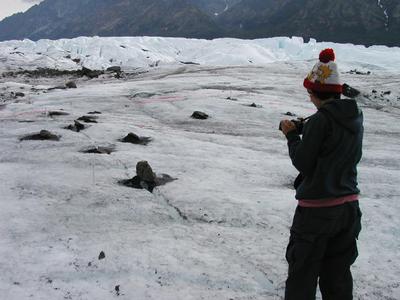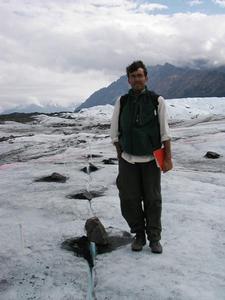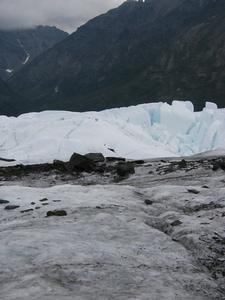29 July, 2001
Looking for tombstones and measuring rocks; Data interpretation-Part 2
6:30 a.m. July 30
Last night, I lent the computer to people who were desperate for e-mail; when
we get used to communicating with friends and family via e-mail, six weeks
becomes a long time to be cut off. Consequently, I did not start my journal
until this morning. So now I write sitting on the deck of the bat cave
(computer tent) listening to the rushing of the river and watching the clouds
play with the sun over the ridges of the Chugach Mountains.
For clarity's sake, from here to the end, I will be referring to July 29 as
"today", "this morning", etc.
Life on ice ... almost
Greg and Kendra left this morning around 9 a.m., as did the guys working for
CRREL. (Greg and Kendra are doing a seismic study near Fairbanks. The CRREL
guys are going camping in Denali National Park.)
With their departures, the atmosphere in the camp changed and shifted to
accommodate the hole left in their absence.
Shortly after they left, Staci and I went to change water bottles at the ISCO
water stations (see Marvin Giesting's journal from last year... He was here
changing these bottles all last summer!).
The rest of the day was spent helping out REU students in one way or another:
Justin is measuring how ice got trapped in the end moraine of the glacier<
/i>
Several days ago, we took GPR data of the area to find the layers of sediment
and use that data to learn something about the history of deposits of
sediment. To make this data as accurate as possible, Justin needed to
measure the elevation (height) of the hills and dips in the area so Greg can
accurately line up the data from below the surface. Justin spent the day
yesterday using a surveyor's tool to measure the elevation of hundreds of
different points in the area. This morning, Nelson, Jeff and I drove into
Palmer to return the rented equipment.
Andrea is measuring lichen growth on the glacier to determine the age of
the different moraines in the area
On the way back, we searched the area for cemeteries. We found one in
Palmer, but none in the former mining towns on the road from Palmer to
Matanuska. We were looking for a way to find out how fast lichen grows in
this area. If we had found a 10 cm patch of lichen on a tombstone from 1951,
we could infer that the lichen grows no faster than 10 cm every 50 years. Of
course, Andrea will have to take lots of samples to make such an inference
confidently AND will have to make sure that everyone understands that lichen
on tombstones in the valley may have different growing conditions than lichen
growing on rocks on the glacier. Even with these limitations, lichen on
tombstones will provide a useful benchmark (a standard from which to measure
or judge) for Andrea's study. We found a couple of likely sites: one in
Palmer (on tombstones in the cemetery) and one in Sutton (at the foundation
of the 1920s-era coal-washing station)
Ranae is measuring trails of rock that have formed on the ice
Near the moraines, rocks and boulders lie scattered across the surface of the
ice. Some of the rocks have melted holes into the ice; others have formed
pedestals many cm high. Ranae calls the bigger rocks that have formed
pedestals mullets (after the hairdo popular in the 80s... short in
front, long in back). She is measuring how big rocks have to be to form
mullets, how the rocks conduct heat (or don't) to the surface of the ice, and
how the rocks move over time on the surface of the ice.
I helped Ranae record the data she was collecting: distance from central
point, azimuth (location of rock relative to the pole, measured in degrees
from north), dip (angle rock was leaning), strike (direction of lean, e.g.,
NW) and the elevation (height) of the rock above or below the ice.
As I mentioned in earlier journals, the collection of data is not always
especially glamorous; it is nonetheless absolutely essential to the process
of science. Reverence and science both begin with taking the time to get to
know something well.
Science at work
Yesterday's work preparing a first-draft interpretation of the data was the beginning of the work to compare and constrast the seismic and GPR data.
I leave the field tomorrow for a brief vacation with family and friends in
south-central Alaska; the data is still there, waiting for further analysis.
In several weeks, I will travel to the University at Buffalo to continue
working with Greg on interpreting this data and preparing it for presentation
at the Geological Society of America's national convention later this fall.
Putting together the many pieces of information that make up our data is a
monumental task and will take considerable time. Due to the complexity of
the data, misinterpretations are easy to make. Careful and thoughtful
analysis will make our time in the field as productive as it was meant to be.
Cheers.
~SM

Ranae is taking a picture of the small crevasse that opened under four(!) of the rocks she is tracking as they move across the ice. Very cool thing to observe in the ice, very sad that it happened in the middle of her experiment!

Here I stand (about 2 seconds before I put on my jacket) ready to record data for Ranae. The wind was howling up the glacier and it was cold!

With the CRREL guys gone for a couple of days, someone else needs to collect their data. Nelson and Andrea hiked to the stakes used to measure ablation , glacier melting. They are the tiny twin lines on near the top of the first hill of clean ice.

After data collection, REU students worked on fine-tuning some details of their projects by talking with the professors. Justin and Mehgan are discussing their projects with Nelson, who is offering constructive criticism and other feedback.

The land and sky are majestic and peaceful as twilight deepens.
Contact the TEA in the field at
.
If you cannot connect through your browser, copy the
TEA's e-mail address in the "To:" line of
your favorite e-mail package.
|
